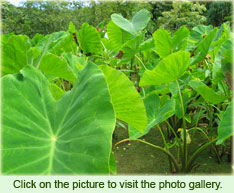
Kalo, or taro, was once abundant in the Hawaiian
Islands. Along with ‘uala (sweet potato) and ‘ulu (breadfruit)
kalo is also a staple of the Hawaiian diet. In addition to making foods
like poi, kalo is also revered in tradition as an ancestor
of the Hawaiian people. In the creation story of Papahānaumoku (Earth
Mother) and Wākea (Sky Father), the islands of Hawai‘i
are born. In addition to the islands, their first human offspring was Ho‘ohōkūkalani,
a daughter. Wākea's desire for his now matured and beautiful
daughter le d him to seek the advice of his kahuna (religious
advisor). The advice of his kahuna established the ‘aikapu (sacred
eating), which became the foundation for Hawaiian spirituality. It was
on one of the kapu (sacred) nights that Wākea was
able to entice the affection of Ho‘ohōkūkalani.
Their first offspring was an “unformed fetus, born prematurely” (Kame‘eleihiwa
1992). They named him Hāloanakalaukapalili. Wākea and Ho‘ohōkūkalani buried
their offspring and from the place where they buried him sprouted the
first kalo plant. They had a second human offspring and named
him after his older sibling, Hāloa. According to tradition
and belief, it is from Hāloa that the Hawaiian people are
descendants of today. The metaphor established here is that ‘āina and kalo are
the elder siblings of the Hawaiian people and therefore deserve much
honor and respect (Kame‘eleihiwa 1992).
d him to seek the advice of his kahuna (religious
advisor). The advice of his kahuna established the ‘aikapu (sacred
eating), which became the foundation for Hawaiian spirituality. It was
on one of the kapu (sacred) nights that Wākea was
able to entice the affection of Ho‘ohōkūkalani.
Their first offspring was an “unformed fetus, born prematurely” (Kame‘eleihiwa
1992). They named him Hāloanakalaukapalili. Wākea and Ho‘ohōkūkalani buried
their offspring and from the place where they buried him sprouted the
first kalo plant. They had a second human offspring and named
him after his older sibling, Hāloa. According to tradition
and belief, it is from Hāloa that the Hawaiian people are
descendants of today. The metaphor established here is that ‘āina and kalo are
the elder siblings of the Hawaiian people and therefore deserve much
honor and respect (Kame‘eleihiwa 1992).
It is from this mo‘olelo (story) that themes and ideas like mālama ‘āina (care for the land) and aloha ‘āina (love for the land) are derived from. The mo‘olelo of Hāloa also demonstrates the cultural importance kalo has for the Hawaiian people. It was not something that just fed the people, but it provided a familial connection between the people and the ‘āina. In families, it is the kuleana (responsibility) of the younger sibling to care for and respect the older siblings. In return, the older siblings are to provide protection, to care for, and to feed the younger siblings. Since according to tradition, the kalo and ‘āina are the older siblings and the Hawaiian people are the younger sibling, it is up to the people to care for and to respect the kalo and ‘āina. Should the people follow and care for the kalo and ‘āina, it will in turn provide food, shelter, and all necessary things needed for life.
Finally, click on the following link for Kalo ‘Ōlelo No‘eau or wise sayings from our kūpuna. In some cases, they are used to describe a particular object, a particular event or even a group of people.